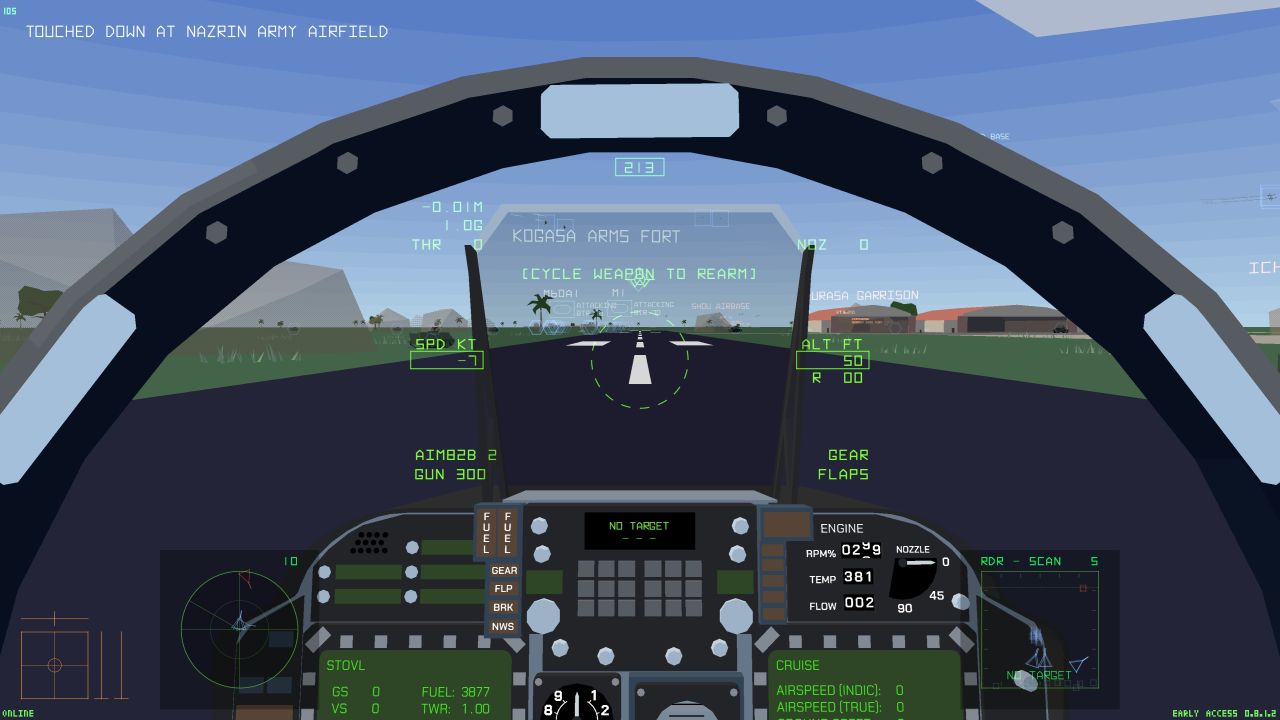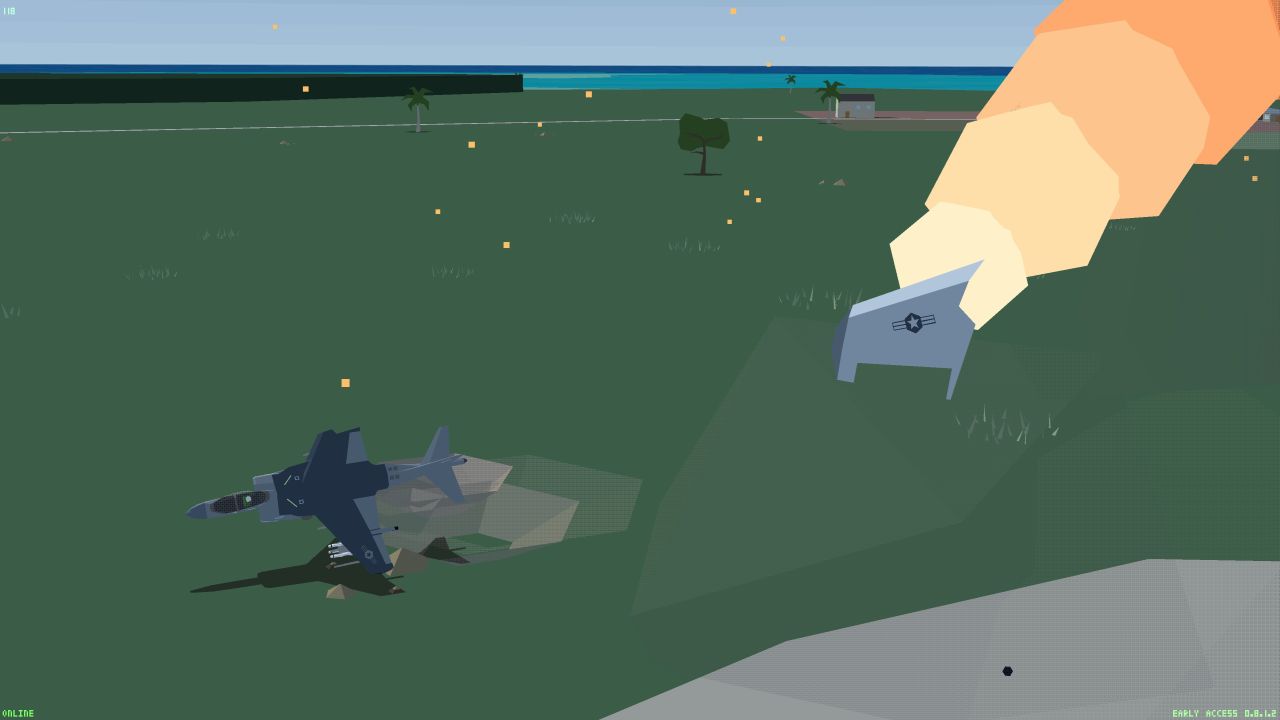So it’s unsurprising that Tiny Combat Arena is about Harriers of the cold and featherless kind. The one-person dev team behind the air-to-air combat simulator is apparently in love with the floaty-shooty jumping jet, so much so that it’s the only type of plane available to fly in the game’s early access release. The retro-styled sim lets you pore over the low-poly plane as it rests in the hangar, to rest your chin in your hands as you lovingly scroll through its various specifications, inspecting its payload like you’re checking a dog over for ticks. As a self-described labour-of-love, Tiny Combat Arena beams with uncynical excitement for planes, and you can’t help but come along for the ride. The Harrier jump jet is beloved among sky-geeks with good reason too: this weirdo plane was invented nearer to the Moon landing than it was to the internet, and stands today as testament to what the world’s smartest engineers can do when given infinite sums of money to think of a way to hide a plane behind a small cloud in the 1960s. Notably, the plane can take off and land vertically thanks to vectored thrust, or pointable nozzles to use the technical term. This allows the aircraft to hide out in forest clearings, mountainous terrain, and behind large billboards, popping up to take enemy forces by surprise. The technology was even briefly considered for use in commercial flights, presumably until a sensible person entered the room and put a stop to that. One last fun fact about the Harrier jump jet. Marcel Duchamp was still alive when the plane was first deployed, meaning he could well have used one to hover around France at night, frightening anyone he didn’t recognise by quietly hovering up behind them and honking the horn, as an art project perhaps. Anyway, Tiny Combat Arena accurately simulates the VTOL capabilities of its creator’s beloved jumping jet. Fun, specific details of the plane’s characteristics are recreated, such as how the Harrier is too heavy to hover when it’s carrying a full loadout of bombs, but can still take off from a short runway by accelerating normally and then cranking the nozzles downwards at the last second for spicy little vertical kick just as the tarmac runs out. The blocky, low-poly visual style presumably serves the one-man developer’s limited art budget nicely, but it also gives Tiny Combat Arena an irresistible style to anyone who grew up playing flight sims in the 90s. Planes are stripped down to their distinctive silhouettes, islands comprise jagged green shards in the sea, explosions are rendered in dull orange, dithered tetrahedrons, expanding gently as any bits of remaining plane are sent arcing through the air and land with a plop in the saltwater. The graphics are reminiscent of Carrier Command, but the flight model and dogfighting is nearer to a super-serious military realism than it is to Ace Combat. This is made clear from the moment you fire up one of the two modes currently available, and find yourself clinically obliterating a distant squadron of AI opponents with air-to-air missiles while they’re still nothing more than specks on the horizon. Tiny Combat Arena isn’t gunning for heavy simulation, but it’s also not one for Top Gun melodrama and sexy showboating flyboys. Like every good sim it’s a reminder that modern plane-fighting is mostly kind of boring, and eerily detached from reality. From the relative peace of your supersonic sky cocoon you depress a small red button, and send a piece of munitions that would pay the salaries of ten billion nurses zipping off into the clouds to find its target somewhere very far away. You can usually only tell if you got the guy if his blip vanishes from your radar seconds later, and your country’s oil interests feel slightly more secure than they did ten seconds ago. You can drop several different flavours of bombs on static and moving ground targets, though I couldn’t tell you why we need more than one type. Sometimes if you’re very lucky, you might get close enough to ruin another plane using your guns, which is the most thrilling aspect of the game so far. Otherwise the combat in Tiny Combat Arena is very basic and not terribly compelling for the average player in search of dramatic explosions and tense, drawn-out battles. The framework of an interesting flying game is in place here, but there’s not much to sink your teeth into yet. A simple 4v4 encounter with a variable difficult setting and an objective-based arena mission lets you fool around with your plane for a while, and there’s a database mode if you want to get stuck into reading about the top speed of guided missiles, but there’s no overarching campaign or any kind of progression to keep you interested for more than five minutes. This is a tale as old as early access, then. Tiny Combat Arena is a labour of love by somebody who’s asking for your support to help them continue creating their dream game. In return you get a ticket to the show long before the theatre is even built, and to enjoy a brief joyride in a cool hovering plane with nowhere to actually go and nothing to actually do for at least another 12 to 18 months. It’s why I spent two paragraphs and a Marcel Duchamp joke talking about the Harrier jump jet, because there’s really very little else to talk about here. Tiny Combat Arena is a little simulation with big ambitions, but if you’re looking for something more substantial than a single plane and a single map, it’s probably best to watch it grow from this side of the “add to cart” button for now. Your £15 would be better spent on 30 credits in an After Burner cabinet on the pier. * The harrier bird shares this dubious honour with a sub-species of southern grey-headed sparrow called The Airbus A380

